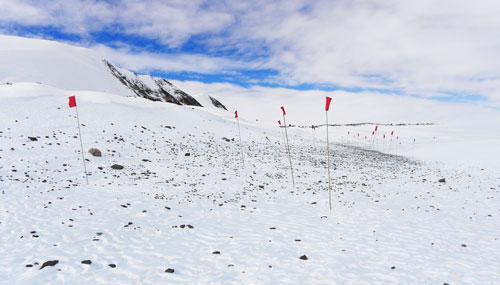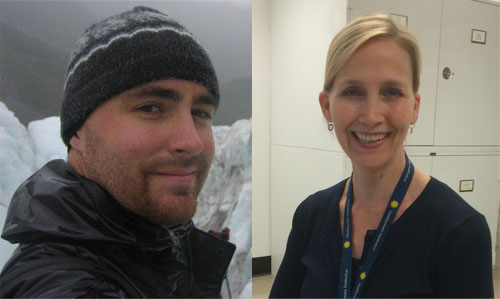Program News
Curator Comments
Kevin Righter, NASA-JSC
This newsletter reports 286 new meteorites from the 2010 and 2011 ANSMET seasons from the Dominion Range (DOM10) and Miller Range (MIL11) areas. Once again, we have a diversity of chondrites, and this newsletter includes detailed descriptions for 27 new carbonaceous chondrites (2 CO3 pairing groups of 20 and 5 samples each, a CR2 and a CM1/2), 2 enstatite chondrites (EL5 and EH3), and four low petrologic grade ordinary chondrites (two LL3.2s, LL3.6, L3.6).
This newsletter includes the last major batch of samples from the 2010 season to be classified, thus nearly completing the characterization from this season. A few additional samples will be announced in the Spring 2015 newsletter. Notable samples from the 2010 season include: 12 HEDs, 1 ureilite, 45 carbonaceous chondrites (CK, CO, CM, CR, CV), 4 enstatite chondrites, 2 hornblende-bearing R chondrites, 5 ordinary chondrite impact melts, and 6 low petrologic type ordinary chondrites. In addition to this diverse cross section of planetary materials, it looks as if the Dominion Range includes a large shower (hundreds of samples) of LL chondrites.
Loan agreements / inventory
Last September we initiated two new policies regarding the loans of Antarctic meteorites from the US collection at NASA JSC: annual inventory and loan agreements. Most of our principal investigators (PIs) have responded to these new policies and we thank you for your time in working through the details of both documents. This has been particularly difficult for those of you who have held samples for several decades. The inventories will be annual and the loan agreement will be good for 5 years. We want to thank you in advance for responding to our upcoming inventory requests in 2015, and just want to remind you that responding to the inventory is a requirement to stay in good standing for receiving new samples from the collection.
Delayed return of 2013 samples
Usually the Fall newsletter reports samples collected from the previous field season, but this year is an exception. At the time of the Spring 2014 newsletter we had just received word that the samples for the 2013-2014 ANSMET season had been stranded at McMurdo due to adverse weather conditions during loading of the cargo vessels in February. Since then, the situation has not changed. The 2013-2014 season samples will be returned in Spring of 2015, along with samples collected during the upcoming 2014-2015 season. So in the Spring of 2015 we will receive two seasons worth of samples here at JSC. So, exciting new samples will be available in 2015.
Book
The past several years, the staff of the US Antarctic meteorite collection has been working on a book project with AGU and Wiley. The book, entitled "35 seasons of U.S. Antarctic Meteorites (1976-2011): A pictorial guide to the Collection" (editors K. Righter, R.P. Harvey, C.M. Corrigan, and T.J. McCoy) , will cover the history, field operations, curation and statistical aspects of the collection, as well as feature articles on primitive chondrites, achondrites, lunar and martian meteorites, unusual meteorites (misfits), and exposure histories. At the center of the book there will be 80 color plates dedicated to 80 of the more influential samples in the collection. This book has been long in the making and should be of interest to a wide range of people from undergraduates to graduates to advanced scholars in the field.
Reclassifications
New information about two samples announced in previous newsletters have indicated a need for reclassification.
MIL 090697: was classified as a L6 chondrite in the February 2014 (Vol.35 No.1) newsletter and is reclassified as a shocked L chondrite. See petrographic description in this newsletter for more information.
DOM 10344: was classified as a CR2 in the February 2014 (Vol.37 No. 1) newsletter.
Petrographic studies and INAA data provided by Alan Rubin and John Wasson (UCLA) indicate that DOM 10344 is an LL3 chondrite, probably LL3.4.
DOM 10344 has higher sulfide contents than a typical CR2. It has radial pyroxene and cryptocrystalline chondrules, which are very rare in CRs, and it has few igneous rims, which are common in CRs. UCLA probe data show Fa10.5 ± 7.5 (n=16) and Fs10.9 ± 8.7 (n=6). The PMD of Fa is 55, corresponding to subtype <3.4. It has rare clear, colorless, isotropic glass, approximately the same as for type 3.4-3.5 OC. Its Cr2O3 in ferroan olivine is 0.07 ± 0.07 wt%, corresponding to type >3.2. So, it is probably best classified as an LL3.4.
In addition, INAA data show 472 µg/g Co and 426 ng/g Ir in DOM 10344. This compares with a mean of 490 and 360 for LL chondrites (from Wasson and Kallemeyn, 1988) and 667 and 642 for CR chondrites from Kallemeyn et al. (1994). Additionally, DOM 10344 contains 129 ng/g Au which does not distinguish it from a CR, but is nonetheless consistent with LL.
New meteorite staff
Mitchell Haller has recently joined the ARES curation staff
Since the March newsletter, the Antarctic meteorite lab has experienced some change in personnel. Kathleen McBride, who has worked in the meteorite collection since 1995 has transitioned to a new position with the dust groups (Cosmic dust and Stardust). Her contributions to the meteorite collection over the years have been enormous, and for example have included processing of most of the martian meteorites and carbonaceous chondrites, both of which require cabinet processing. In addition to this work she has done the initial characterization of thousands of Antarctic meteorites. Her expertise and experience will be missed for sure, but the good news is that she is still with the Curation group.
In June, Mitchell Haller joined the curation staff at ARES and has been fully integrated into the Antarctic meteorite team. You will see Mitch’s name on many of the descriptions in this newsletter and he will be working closely with Cecilia Satterwhite on all of the aspects of meteorite curation. Mitch received his B.S. in Geology from SUNY-Potsdam in 2014.
Preview of the 2014-2015 field season
Ralph Harvey, Principal Investigator, ANSMET
The 2014-2015 field season takes ANSMET back to the Davis-Ward icefields, one of a number of productive meteorite stranding surfaces in the southern headwaters of the Beardmore Glacier. ANSMET has visited the Davis-Ward icefields four times previously. Reconnaissance visits in 1985 and 2003 demonstrated the potential of the site, and later systematic searching visits in 2008 and 2010 led to the recovery of over 1000 meteorites from these icefields. Meteorites recovered from the Davis Ward site bear the DOM sample prefix, as do samples recovered from the nearby Dominion Range icefield.
The Davis-Ward site is fairly compact compared to many of the places ANSMET has worked, with a main icefield in the form of a pendant glacial tongue filling the area between Mt. Ward and the Davis Nunataks. A terminal moraine along the tongue's northern edge connects “Davis” to “Ward” and separates this main icefield from a set of icefields of similar total area on the downhill side of this moraine. The entire site is only about 10 km across, making daily commutes from camo to almost any recovery area quite reasonable. This is welcome change from places like the Miller Range where a trip from one end to the other can be a day-long production.
The proximity of Davis Nunataks and Mt. Ward to the exposed ice means that terrestrial rocks are common on almost all parts of these icefields. Even worse, most of these consist of dark, fine-grained dolerite and basalt, making it difficult to identify meteorites at a distance. There is a silver lining, however; several locations harbor a fantastically high spatial density of meteorites. In one such location, a linear depression informally known as “the Trough” (aptly named given the feeding-frenzy it often produced) it is not unusual for several dozen meteorites to be found on an area the size of a football field (see photo). Most days (weather-permitting) at Davis-Ward are productive and include a significant amount of warmth-inducing foot-searching.
“The Trough” at the foot of Mt. Ward, with 27 meteorite flags in view
Given some of the difficulties we faced last season (primarily due to last October’s government shutdown) the unassuming and straight-forward job ahead of us at Davis-Ward is something to look forward to. Of course it’s still a trip to the end of the Earth, so nothing is ever completely normal and predictable, and we’ll bring our usual flexibility to the situation as we get ANSMET’s 38th field season underway.
Report from the Smithsonian
Cari Corrigan, Geologist (Dept. of Mineral Sci.)
This newsletter reports the classification of meteorites from the 2009, 2010, and 2011 ANSMET seasons. With the 2013 samples trapped in McMurdo, we are busy trying to close out the 2010 season, and with the publication of this newsletter, we will only have a few iron meteorites left to report. Stay tuned for Spring 2015!
We have recently welcomed the following to the Division of Meteorites: Dr. Devin Schrader (Ph.D. 2012, University of Arizona), a new post doc, and Dr. Pam Salyer, who has been working with museum collections for the past two years and began working with us in the meteorite collection last fall. They have both been great additions to our group.
Dr. Devin Schrader and Dr. Pamela Salyer have recently joined the Smithsonian's Division of Meteorites
Linda Welzenbach at the Smithsonian's meteorite lab
It is with mixed emotions that we report the impending departure of Linda Welzenbach, our Meteorite Collections Manager for the past 15 years. During this time she has had many accomplishments, including participation in the classification of almost 10,000 Antarctic meteorites, traveling to Antarctica to collect meteorites during two ANSMET seasons (2002 and 2005), and digitizing the meteorite collection. She has also overseen the major renovations/construction of our two meteorite storage facilities. Linda will be moving to Houston, TX, in November, to join her husband-to-be. While we will be very sorry to see her go, and will miss her expertise, we wish her all the best and thank her for her commitment to the care of the US Antarctic Meteorite Collection over the past 15 years.




